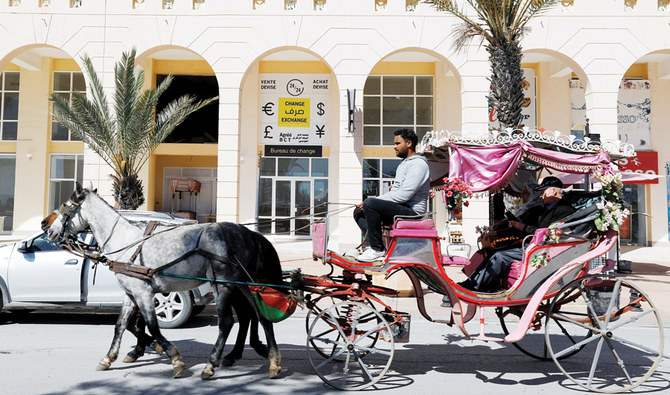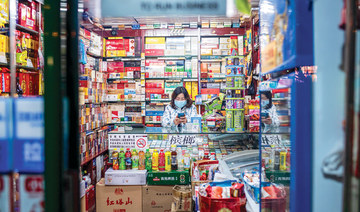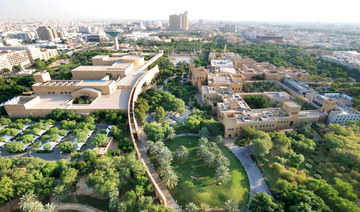HAMMAMET, TUNISIA: Ammar Jouini had been optimistic about this year, hoping that after Tunisia’s tourism sector finally recovered from years of pain caused by militant attacks in 2015, his souvenir business might also be looking up.
But with the coronavirus devastating holiday bookings, he is thinking of shutting up his shop in the popular beach resort of Hammamet and seeking new work for the season. “I have to wait three or four days to sell only one piece. My costs are much higher than my income. It seems the difficulties will return again,” he said.
Tunisia had been gearing up for a season of record visitor numbers that politicians hoped would make up for gloom elsewhere in the economy. But last week Prime Minister Elyes Fakhfakh said forecast economic growth had fallen to 1 percent from 2.7 percent, citing the virus.
In another blow to the tourist trade, Tunisia has announced it will require everyone arriving from abroad to self-isolate for two weeks.
Tourism accounts for nearly a tenth of Tunisia’s economy, is its second-biggest employer after agriculture and provides an important source of foreign currency.
The crash that followed the 2015 attacks caused gross domestic product (GDP) growth to slow to 0.5 percent that year from an expected 3 percent. It contributed to a sharp fall in the value of Tunisia’s currency the following year and ongoing economic troubles.
Tunisia agreed to a loan program in 2016 with the International Monetary Fund but it expires in April and the new government, agreed in February after months of wrangling, is now trying to negotiate a replacement.
Jouini’s shop is far from the only business facing hard times in Hammamet, where resorts stretch along the sandy beach each side of the pretty walled city and its fort.
While Jouini spoke, other souvenir sellers played football in the street, their shops empty. Nearby, Ramadan Jlassi sat with his horse-drawn carriage, waiting for customers.
He does not earn more than 10 dinars ($3.50) a day and has three sons, he said. “It is hard to buy the basics for my family,” he said.
Canceled reservations
Tunisia has confirmed 13 cases of the coronavirus.
Spring bookings at the Hasdrubal hotel, one of the smartest in town, stand at 15 percent, a quarter of the usual level in March, said general manager Samir Ncir.
“There is stagnation. Many reservations were canceled,” he said. The hotel is not yet planning to lay off staff though it may delay signing up seasonal workers, hoping that the epidemic will pass and tourists will return in
the summer.
“We expect the pattern to return at the end of May and the beginning of June. But we may have to put off signing contracts with casual workers in the summer,” he said.
But for Jouini, who has two children, the outlook is not good. “It will be complicated for me and my family because this is our only income,” he said.
Tunisian beach resorts face up to coronavirus blight
https://arab.news/grz5x
Tunisian beach resorts face up to coronavirus blight

- Tunisia has confirmed 13 cases of the coronavirus
Oil Updates - Oil slips after Fed signals no rush to cut rates as key US inflation data awaited

HOUSTON/BEIJING: Oil prices fell in Asia on Friday as comments from a Federal Reserve official bolstered expectations of rates staying higher for longer, a view that will be tested later in the day with a keenly-awaited US inflation report, according to Reuters.
The market, which is waiting on a weekend OPEC+ decision on production cuts, was weighed down in overnight trade by a surprise build in US gasoline stocks.
Brent futures were down 3 cents, or 0.04 percent, to $81.83 per barrel at 9:01 a.m. Saudi time, while US West Texas Intermediate crude fell 10 cents, or 0.13 percent, to $77.81.
Dallas Federal Reserve President Lorie Logan said she is still worried about upside risks to inflation despite recent easing, warning that the US central bank needs to be flexible and keep “all options on the table” as it watches data and determines how to respond.
“It’s really important that we don’t lock into any particular path for monetary policy,” Logan said at an event in El Paso, Texas. “I think it’s too soon to really be thinking about rate cuts.”
Markets are cautious ahead of the release of a key gauge of US inflation on Friday, said Yeap Jun Rong, a market strategist with IG. The April report on personal consumption expenditures, the Fed’s preferred inflation index, is due later in the global day.
The oil market has been under pressure in recent weeks over the prospect of US borrowing costs staying higher for longer, which could potentially tie down funds and hurt crude consumption.
Meanwhile, US crude oil inventories fell 4.2 million barrels to 454.7 million barrels in the week ending on May 24, the Energy Information Administration said on May 30, compared with expectations in a Reuters poll for a 1.9 million-barrel draw.
Gasoline inventories, however, rose in the US against an expectation that demand would be higher ahead of the long Memorial Day weekend, which signals the start of the summer driving season. Stocks were up 2 million barrels for the week to 228.8 million barrels, the EIA said, compared with expectations for a 400,000-barrel draw.
Elsewhere, OPEC+ is working on a complex deal to be agreed at its meeting on June 2 that would allow the group to extend some of its deep oil production cuts into 2025, three sources familiar with OPEC+ discussions said on May 30.
“A significant driver for oil prices ahead will revolve around the upcoming OPEC+ meeting this weekend,” Yeap said. “Any further cuts may be unlikely and will be seen as a huge surprise.”
The Organization of the Petroleum Exporting Countries led by Saudi Arabia and allies led by Russia, together known as OPEC+, are currently cutting output by 5.86 million barrels per day, equal to about 5.7 percent of global demand.
GCC countries to lead Mideast energy transition

- Saudi Arabia, UAE, and Oman to account for two-third of region’s solar capacity
RIYADH: Saudi Arabia, the UAE, and Oman are set to lead the Middle East’s solar transition thanks to several key factors, according to a new report.
In its latest analysis, Norwegian business intelligence and research company Rystad Energy stated that solar power is becoming increasingly important in the energy policies of Middle Eastern countries.
As the cheapest energy source, solar photovoltaics in Saudi Arabia has achieved a world record-low levelized cost of electricity of $10.4 per megawatt-hour, the report stated. It further explained that this is due to factors such as low hurdle rates, large-scale projects, and declining hardware prices, as well as low labor costs and high solar irradiance.
“The region has exceptional solar energy potential, receiving more than 2,000 kilowatt-hours per sq. m. annually in solar irradiation in countries such as Saudi Arabia, the UAE, and Oman,” the report stated.
The total solar capacity in the Middle East at the end of 2023 exceeded 16 gigawatts and is expected to approach 23 GW by the end of 2024, the report added.
Rystad Energy’s projections indicate that by 2030, the capacity will surpass 100 GW, with green hydrogen projects contributing an annual growth rate of 30 percent.
The report stated that Saudi Arabia, the UAE, and Oman are on track to collectively account for nearly two third of the region’s total solar capacity by the end of the decade.
By 2050, renewable sources, including hydro, solar, and wind, are expected to constitute 70 percent of the Middle East’s power generation mix, a significant leap from 5 percent at the end of 2023, the report stated.
Despite this surge, the region will rely heavily on natural gas in the short term, with usage peaking around 2030.
The report added that at the end of 2023, 93 percent of the Middle East’s power generation was from fossil fuels, with renewables at 3 percent and nuclear and hydro at 2 percent each.
By 2030, 30 percent of installed capacity is expected from renewables, potentially reaching 75 percent by 2050.
Rystad Energy predicts battery energy storage will grow significantly in the 2030s, supporting the transition to solar and wind power. The share of gas in power generation is expected to decrease from 74 percent in 2023 to 22 percent by 2050.
Saudi Manpower Solutions Co. eyes expansion following its public listing

RIYADH: Various sectors across different parts of Saudi Arabia will soon have greater and easy access to manpower as the country’s first service provider eyes expansion with its initial public offering.
Speaking to Arab News, Abdullah Al-Timyat, CEO of Saudi Manpower Solutions Co., known as SMASCO, said the IPO will help propel SMASCO within the Saudi market, drive growth initiatives, and fortify its presence and stakeholders’ trust.
Al-Timyat said the IPO proceeds will not be utilized for internal operations but will be earmarked for strategic growth initiatives to expand the company’s footprint across the Kingdom’s diverse market.
He added the company’s capital-light model, fortified by no debt and robust cash management, positions it for agile expansion. “We have zero debt and funding. We have strong cash management, and we have enough internal funds for our operations. So, the IPO will enable SMASCO in its future steps and strategic direction in expanding within the Saudi market, reaching new geographic cities and regions within Saudi Arabia.”
With an eye on deepening market penetration, Al-Timyat outlined SMASCO’s strategic direction, leveraging the IPO’s support to enhance brand awareness and stakeholders’ trust.
“We will even go deeper … within specific sectors, in business industry and professional manpower, depending on a more trusted bond that we have available because of the IPO and the support that we will have.”
The executive outlined the company’s current focus on the Kingdom’s market, emphasizing its vast potential and opportunities for manpower companies, including SMASCO.
He also underscored the entity’s mature model and expertise in technologies, which position it to potentially expand into new markets in the future. While there are no immediate plans to venture beyond Saudi Arabia, SMASCO remains prepared to seize opportunities should they arise, he said.
Looking ahead, the CEO highlighted artificial intelligence’s transformative potential emphasizing its role in enhancing efficiency and service delivery.
He said: “AI and advanced technology is an opportunity for manpower companies. This is how we see it in SMASCO, this will provide us more opportunities, a faster a road to (achieve) our objectives operationally, financially and even for our customers.”
Al-Timyat highlighted the pivotal role of Vision 2030 benchmarks in providing clarity and direction to SMASCO’s future endeavors.
“Since the government launched Vision 2030, we have a clarity where we are going and this makes it easier for any industry, for any investor. We see a persistence of execution by the government, which we have never witnessed before and this is actually aligned with what we are seeing.”
This synergy between technological innovation and national objectives supports industry advancement. The executive noted that it is set to drive economic growth and societal development in alignment with the Kingdom’s ambitious vision.
Al-Timyat also outlined the global demand for various industries, including medical, logistics, tourism, and entertainment, which are also prevalent in Saudi Arabia.
Each of these industries requires specific qualities for talents and specialized manpower services to address their unique needs, he noted.
The executive said SMASCO, specialized in manpower solutions, has created subsectors within its team to cater to diverse industries.
This focus on specialization enables SMASCO to provide high-quality services that align with the economy, market trends, and specific requirements of each industry.
Saudi banks’ risk profiles stronger than GCC counterparts: Fitch

RIYADH: Saudi banks exceed their Gulf Cooperation Council counterparts in terms of risk profiles underpinning their asset quality, according to Fitch Ratings.
The credit rating agency said in a statement that there is a strong correlation between asset quality and risk profile scores among regional banks, particularly in the GCC, due to their lending-focused business models. Saudi banks boast a weighted-average risk-profile score slightly below “bbb+” and a similar asset quality score.
Conversely, in the UAE, Qatar, and Kuwait, both weighted-average scores stand two notches lower, at “bbb-.”
Despite experiencing credit growth around double the GCC average between 2022 and 2023, Saudi banks maintain stronger scores. This surge is attributed to heightened government spending and robust non-oil gross domestic product growth.
However, banking assets remained at 99 percent of GDP by the end of 2023, contrasting with figures of 206 percent in the UAE, 240 percent in Qatar, and 159 percent in Kuwait.
The stronger risk profiles of Saudi banks are evident in their asset quality metrics. From 2019 to 2023, the sector’s cost of risk averaged 60 basis points, lower than the averages observed in the UAE, Qatari, and Kuwaiti banking sectors.
Similarly, the combined Stage 2 and 3 loans ratio of 7.2 percent was the lowest among the four markets.
Fitch’s assessment of Saudi banks’ stronger risk profiles reflects their generally conservative underwriting standards and risk controls.
This evaluation also acknowledges the perception that the Saudi Central Bank, also known as SAMA, is the region’s strictest and most prudent banking regulator.
“Saudi banks have less borrower concentration than the UAE and Qatari banks, but a similar level to Kuwaiti banks, due to a larger and more diversified economy and strong retail financing in 2021-2023,” the rating agency stated.
It added: “The 20 largest exposures at Saudi and Kuwaiti banks account for about 20 percent of the loan books on average, but significantly more — about 35 percent — at UAE and Qatari banks.”
Moreover, Saudi banks extend lower levels of financing to companies owned or managed by high-net-worth individuals compared to certain UAE and Qatari banks.
Saudi banks’ exposure to real estate and construction companies rose to 15 percent of gross sector financing by the end of the first quarter of 2024, up from 12 percent at the end of 2021.
This trend is anticipated to persist as non-oil sectors continue to expand. While Saudi banks’ real estate financing proportion now resembles that of Qatari and the UAE banks, it remains below the average for Kuwaiti lenders, standing at 24 percent of gross loans as of end 2023.
“We typically view high exposure to real estate financing as a weakness for GCC banks’ risk profiles and asset quality, as the exposures are mostly long-term and often non-amortizing with final repayment contingent upon full completion of the building,” Fitch said in the statement.
It added: “Potential difficulty in realizing underlying collateral or repossessing prime residences can also weigh on how Fitch views the exposures.”
Riyadh residential market sales surge 77%: CBRE report

RIYADH: Saudi Arabia’s residential market experienced robust growth in demand, with Riyadh witnessing a 77 percent year-on-year increase in sales transactions in the first quarter, a new report showed.
According to global consultancy firm CBRE, Jeddah residential transactions surged by 92.9 percent in the first three months of this year, while Dammam saw a 28.0 percent increase year-over-year.
Taimur Khan, head of research MENA, said: “Whilst we have seen strong performance across commercial sectors within Saudi Arabia in the recent past, something which continues to date, we are now beginning to see the residential sector also register a significant surge in demand. This is, in turn, underpinning performance in the sector.”
As new stock continues to be delivered, he said they expect this trend to continue, with demand outpacing supply for some time to come.
“However, we also expect that there might be some bifurcation in performance within the residential sector, with new quality assets likely to register record rates,” added Khan.
Villa prices in Riyadh, Jeddah, and Khobar rose by 3.6 percent, 0.2 percent, and 3.1 percent, respectively. Meanwhile, Dammam saw a slight decline of 0.5 percent.
In the apartment segment, prices in Riyadh, Dammam, and Khobar increased by 8.4 percent, 0.9 percent, and 0.4 percent, respectively, compared to the previous year.
However, Jeddah experienced a 1.1 percent decrease in average apartment prices over the same period.
Throughout the first quarter of this year, the office sector witnessed a slowdown in rental growth across all market segments.
Prime rents in Riyadh’s occupier market surged by 14.5 percent, while Grade A and Grade B rents increased by 11.8 percent and 10.3 percent, respectively.
In Dammam, Grade A rents rose by 8.0 percent, Grade B by 6.2 percent, and Khobar’s Grade A rents saw a 4.6 percent increase.
Occupancy rates stood at 93.8 percent, 99.7 percent, and 99.4 percent for Prime, Grade A, and Grade B segments in Riyadh, while Dammam and Khobar displayed respective Grade A occupancy rates of 86.3 percent and 85.2 percent as of the first quarter.
In Jeddah, Grade A and Grade B rents increased by 13.6 percent and 13.1 percent, respectively, with occupancy rates reaching 92.5 percent and 86.6 percent.
The hospitality sector’s performance remained strong throughout the first quarter due to high visitation levels.
Year-on-year, from January to March 2024, the average occupancy rate saw a slight uptick of 0.1 percentage points.
Additionally, the country experienced an 11.8 percent increase in average daily rate, leading to a 12.0 percent rise in revenue per available room.















